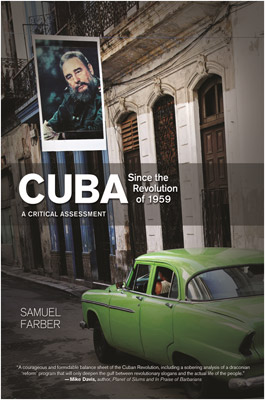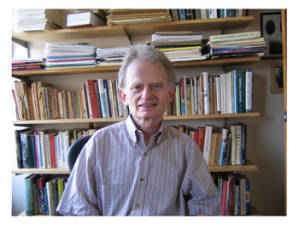Cuba: A Critical Assessment Book Review
By Sheyla Hirshon*
 HAVANA TIMES, Feb 2 — Let me begin with a disclaimer: If a book reviewer presupposes some level of equal knowledge to the author’s, then I am in no way qualified to write this.
HAVANA TIMES, Feb 2 — Let me begin with a disclaimer: If a book reviewer presupposes some level of equal knowledge to the author’s, then I am in no way qualified to write this.
Samuel Farber has written a meticulously researched historical and political analysis, and even the briefest look at the sources praising the work on the back cover — professors emeritus and scholars from Cuba — affirms that I am out of my league.
I have no academic credentials or pretensions. I simply consider myself someone who grew up with capitalism and dislikes it profoundly, as I have been witness to its more brutal forms, particularly in Nicaragua. Therefore, to me — as to millions — Cuba represented the dream of a better, kinder, more egalitarian system.
This illusion, insofar as I was able to maintain it at all, has been challenged by two visits to the island and by my periodic reading of Havana Times, particularly its diaries. There, the intensely personal and articulate vignettes speak to the huge gap between my own cherished desire for a better society and the day-to-day realities of peoples’ lives in Cuba.
Further, it is clear that not all of that distance can be traced to the difficult road that the island has been obliged to travel.
Given this (and HT’s editor urging me to “write it anyway”), I approach Cuba Since the Revolution of 1959: A Critical Assessment with two vital questions: 1) Is this book accessible and helpful to those without an academic background, and 2) can we trust Samuel Farber to be our guide and teacher in this endeavor to understand Cuba’s past and present?
This latter question, which of course would never arise in a book analyzing, say, the history of Luxembourg, becomes inescapable when dealing with this island – a circumstance so distorted by our own desire to see a morality play instead of the true landscape.
Admirable clarity
For those who have not read the book or the chapter summaries presented in Havana Times, I can quote the author’s explanation where he says: “My explicit political aim is to present an alternative view to two influential perspectives: first, the view of those opponents of the Cuban system who would replace it with the rule of the capitalist marketplace…and a direct or indirect reassertion of US hegemony over the island: second, the arguments of those who apologize for the Cuban system…”
He does this by dividing the issues into seven chapters, covering the Cuban political system, economic successes and failures, foreign policy, workers’ rights, racial equality, gender politics and finally a view of the criticisms from the left and right.
The first question regarding accessibility to the common reader can be answered in the first few pages: Yes, Samuel Farber is an excellent teacher, summarizing his chief conclusions in an introduction and building his case clearly with only occasional detours into issues of controversy among Marxist theorists.
While I found myself at first bemused by the objectivity of his writing — with none of the storytelling and subjective presentation that marks most modern non-academic writing — I quickly grew to value the clarity and care with which he presented and documented his arguments. I found his historical overview of Cuban society particularly illuminating, reminding us that Cuba did not emerge from the ocean in 1959 but from a very particular history of its own.
This is of course important since it’s a rather dismaying journey for those of us who have invested our collective hopes in Cuba. Farber traces many of Cuba’s difficulties to the original decision to organize the government as a monolithic one-party state to organize production and distribution and then harness their fruits to offer the people the gifts of social welfare.

He contrasts this with more democratic forms of socialism, then analyzes in agonizing detail the many failures of the one-party system: including disastrous economic failures, waves of political and cultural repression, a foreign policy that moved from spreading the revolution to a sometimes contradictory realpolitik, and a general failure to develop a better standard of living for the Cuban people.
The author is careful to let us know that he is a firm opponent of the US blockade and of any outside attempts to intervene in Cuba. He states, “Cuba has an inalienable right to make its own decisions and to enjoy normal relations.” He is also extremely careful to distance himself from the right and to note that none of his criticism is meant to imply that the solution can be found in the capitalist marketplace.
He does, however, offer us repeated chains of analysis showing that the flaws in the Cuban system were not brought on by the embargo or by reactions to US hostility, but by problems inherent in the leaders’ choice of direction. Although at times his unrelenting recitation of failures can be hard to read, he makes it abundantly clear what he is concluding and why he is concluding it.
So, to answer my first question, this is not exactly enjoyable reading, but the book Cuba Since the Revolution of 1959: A Critical Assessment is a superb accompaniment for readers of Havana Times who would like to understand in more depth what the diary authors are describing to us.
The inevitable question of trust
The second question, of course, inevitably arises when we talk of Cuba, where so many people outside the island have colored the realities with their own passions.

In this, I found myself ending the book humbly grateful to the author for so many things, including his impeccable scholarship and his implacable commitment to the truth, even as he notes that the truth can be a slippery concept: “I believe, contrary to most post-modernist theory, that there are such things as facts, and that it is a worthy goal to present reality as truthfully as possible. But…no one can simply be an empiricist, a compiler of nothing but the facts. Judgments have to be made.”
He makes his own perspective and intentions abundantly clear: “This book is…an attempt to be a political reflection on history and a search for a usable past, which hopefully will support the new voices emerging in Cuba advocating a progressive transition toward a revolutionary and democratic form of socialism.”
Farber remains true to that perspective, building his case through the nearly 300 pages of detailed analysis. Personally, one of the more novel aspects was the tracing of the gender movements and the racial question back through the century, reminding us that this revolution was not born out of a textbook but out of a set of national perspectives and realities.
A few criticisms? Personally, as an educator, I would have appreciated more information regarding the theories and practices that have shaped the Cuban educational system, as I believe this is crucial in creating either a critical populace or a submissive one.
Secondly, as someone with a strong connection to Nicaragua, I missed a full consideration of the early Sandinista years and its repercussions on the situation in Cuba, and vice versa.
Finally, I ended up accepting Farber’s evidence that the decision to develop Cuba based on the model of an omnipotent one-party State was an early unilateral decision of the leadership, but I am left with the question of “why?”
This of course, is the unknowable, and Farber — true to his promise to base himself on facts — makes no attempt to answer it.
The book left me with a profound sense of concern for the future of Cuba. I look with renewed respect and perspective at the HT writers who I have come to look upon as colleagues in the sometimes blind struggle to deal with the many failures we are all born into and to mold them into something better.
—–
*Sheyla Hirshon is the author of “And Also Teach Them to Read” on the literacy crusade carried out in Nicaragua in 1980.
CUBA SINCE THE REVOLUTION OF 1959
A Critical Assessment
Copyright Samuel Farber 2011.
(www.haymarketbooks.org)






I also have bought this book after reading about it on this website. I haven’t read all of it yet – it’s quite a negative, depressing read. I did feel that it was overly critical on occasions, for example, Farber talks about the centralisation of distribution of all sorts of agricultural production, citing the fact that soft drinks travel 200km to a warehouse and then are distributed to retail shops, some of which are near the original factory. Yes, he has a point, but in the advanced capitalist countries the same model of distribution takes place, infact even more absurdly so. In the UK there are 5 or 6 supermarket chains that control 80% of trade. So manufacturers send their products to each supermarket’s warehouses and then each warehouse sends the goods out to its shops, some of which will be in the same town as the food factory. What’s the difference? I should imagine that only subsistence economies do not have this model.
Thanks Sheyla! Well done.